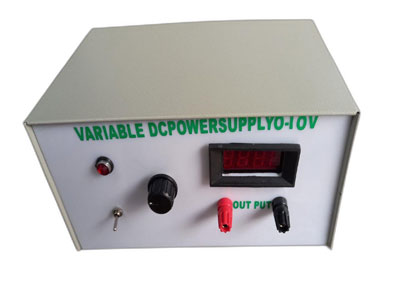Key Takeaway
A variable power supply allows you to adjust the output voltage and sometimes the current. This means you can set it to provide different levels of power depending on your needs. It’s especially useful in electronics projects and testing because it can mimic various power conditions. You can fine-tune the voltage to match the requirements of different devices, ensuring they operate correctly. This flexibility makes it a vital tool for engineers and hobbyists alike, as it supports a wide range of applications and experiments with ease.
Definition and Working Principle
A variable power supply is an essential device in industrial applications, designed to provide adjustable output voltage and current. It allows users to set the desired levels according to their requirements, making it highly versatile. Typically, it converts the fixed input voltage from a power source into a variable output. This is achieved using electronic components such as transformers, rectifiers, and regulators. By varying these components, the output voltage and current can be controlled precisely. Variable power supplies are crucial in testing and prototyping, where different voltage levels are needed to evaluate components and circuits.

Key Features
When discussing variable power supplies, several key features stand out, making them essential tools in industrial applications. One of the primary features is the adjustable voltage and current limits, allowing precise control over the output. This flexibility is crucial for tasks requiring specific voltage or current levels. Many models come equipped with digital displays, providing real-time readings of voltage, current, and power. This feature enhances the accuracy of your work by allowing constant monitoring and adjustments as needed.
Safety is a paramount concern, and variable power supplies often include overvoltage, overcurrent, and short-circuit protection. These features ensure that both the equipment and the user remain safe during operation. Advanced models offer programmable settings and remote control capabilities, which can significantly streamline industrial processes by allowing automation and reducing the need for manual adjustments. Additionally, fine and coarse adjustment knobs provide enhanced precision, making it easier to set exact values for your tests and experiments. Multiple output channels are another valuable feature, enabling the simultaneous testing of several devices, thus increasing efficiency and productivity in industrial settings.
You May Like to Read
Applications and Use Cases
Variable power supplies find extensive applications across various industrial sectors, making them indispensable tools. In manufacturing, they are used to test and power different electronic components and systems, ensuring that each component functions correctly before being integrated into a final product. Research and development labs heavily rely on variable power supplies for prototyping and experimentation. Engineers can simulate different conditions and observe how their designs perform, facilitating innovation and improvement.
Educational institutions also benefit from these versatile devices. In teaching laboratories, variable power supplies help demonstrate electrical principles to students, providing hands-on experience with real-world equipment. This practical exposure is invaluable in understanding theoretical concepts. Other common use cases include battery charging, where precise voltage control is necessary to prevent damage, powering microcontrollers in various applications, and operating radio frequency (RF) equipment. The versatility of variable power supplies ensures they are valuable in any industry dealing with electronics, enhancing both learning and innovation.
Advantages and Disadvantages
The flexibility of variable power supplies is one of their most significant advantages. They can be adapted for a wide range of applications due to their adjustable output, making them suitable for diverse industrial tasks. The precise control over voltage and current is another major benefit, enhancing the accuracy of tests and experiments. Safety features such as overvoltage, overcurrent, and short-circuit protection provide peace of mind, safeguarding both the user and the equipment.
However, there are also some disadvantages to consider. Variable power supplies can be expensive, particularly models with advanced features like programmable settings and remote control. This cost can be a barrier for small businesses or individual users. Additionally, they can be complex to operate, requiring a learning curve for those unfamiliar with the equipment. This complexity can lead to mistakes or inefficiencies if not properly addressed. Furthermore, the size and weight of some models may pose challenges in space-constrained environments, making them less convenient to use or store. Despite these drawbacks, the benefits often outweigh the disadvantages, especially in professional and industrial settings.
Selecting the Right Variable Power Supply
Choosing the right variable power supply involves careful consideration of several factors to ensure it meets your specific needs. Start by assessing the voltage and current range required for your applications. Ensure the power supply can deliver the necessary output levels to avoid any limitations in your work. Next, examine the accuracy and stability specifications, as these will directly impact the precision of your tasks. Accurate and stable outputs are crucial for reliable results.
Safety features should not be overlooked, especially if you work with sensitive or expensive equipment. Look for models with comprehensive protection mechanisms to prevent damage and ensure user safety. If your work involves automation, consider power supplies with programmable settings and remote control options. These features can significantly enhance efficiency by reducing the need for manual intervention. Additionally, the number of output channels is an important factor; multiple channels allow for simultaneous testing of different devices, increasing productivity. Finally, features like digital displays and fine adjustment knobs can make the power supply more user-friendly and precise, ensuring that you can set and monitor exact values with ease.
Conclusion
A variable power supply is a versatile and indispensable tool in industrial applications, providing adjustable voltage and current for various needs. Understanding its working principle, key features, and applications can help in selecting the right model for your specific requirements. While they offer significant advantages in terms of flexibility and precision, it’s essential to consider the potential disadvantages and ensure you choose a power supply that meets your needs. By doing so, you can enhance the efficiency and accuracy of your testing, prototyping, and educational activities, making the most of this valuable tool.
